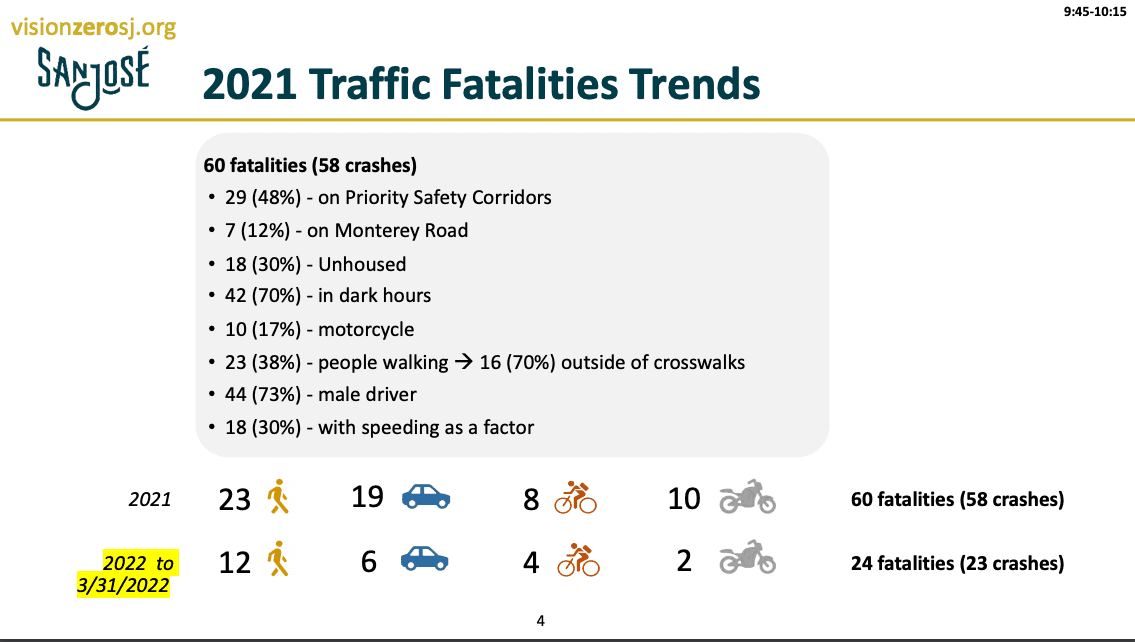San Jose officials are scrambling to reduce traffic fatalities following a massive spike in deaths at the beginning of the year.
Stakeholders in the city’s Vision Zero Task Force met Wednesday to discuss infrastructure fixes and communication campaigns to make the roads safer for pedestrians and cyclists.
Hanging over the meeting was the fact that 24 people have died in traffic collisions in 2022—almost triple the tally this time last year and already more than a third of all traffic deaths reported in 2021. With 60 traffic deaths last year, San Jose matched its previous record-high for fatalities from 2015 and 2019.

“We are seeing unprecedented numbers of traffic related fatalities,” said San Jose Councilmember Raul Peralez, who chairs the Vision Zero Task Force. “It should be all of our goals to reduce that trend.”
Peralez recently pushed the city to prioritize funding traffic safety projects and wants to evaluate the effectiveness of Vision Zero’s action plan. It’s a priority shared by other officials, including Mayor Sam Liccardo, who recently announced a $6 million plan to build more pedestrian street barriers and protected bike lanes. Peralez plans to hold a town hall next month with Councilmember Pam Foley, who serves as vice chair of the Vision Zero Task Force, to discuss the city’s traffic safety issues.
According to Jesse Mintz-Roth, Vision Zero program manager, the uptick in deaths from last year and the first months of 2022 is due to the reopening of the economy last June.
“During the pandemic, the numbers were low, and into the first half of 2021 the numbers continued to be low,” Mintz-Roth said. “But when the economy reopened in June, we started to see this trend line go beyond normal.”
Speeding remains the leading cause of death on roads, accounting for 30% of last year’s fatalities. Mintz-Roth said 88% of fatalities in 2021 occurred on streets that allow speeds of 35 miles per hour or higher, and 12% of fatalities happened on one street—Monterey Road.

Another alarming trend is the growing number of unhoused people killed in traffic collisions. In 2018, the city recorded one homeless pedestrian killed by a car; in 2021, that number spiked to 18.
Neil Rufino, assistant parks director, said Beautify SJ—a city organization that supports neighborhood clean-up projects—is handing out information cards at homeless encampments and has requested reflective vests to distribute to unhoused people.
Peralez asked the county medical examiner to provide information about whether any of the unhoused people killed by cars were intoxicated. Foley seconded this request, noting there have been three fatalities on Almaden Expressway near a bar.
“It would be good to have that data to know if (intoxication) was a contributing factor or not,” Foley said.

The city continues to work on infrastructure improvements, such as quick build projects to slow down traffic at dangerous intersections, and fences built along medians to discourage illegal pedestrian crossing. Lily Lim-Tsao, deputy transportation director, said low department staffing levels slow the progress of these projects.
“It’s disheartening from an operations standpoint we couldn’t do much more in a quicker manner,” she said.
Officials are also waiting on the outcome of a couple pieces of state legislation that could potentially give San Jose more tools for controlling traffic.
Liccardo recently testified in favor of Assembly Bill 2336, which would allow San Jose and several other cities to implement automatic speed enforcement cameras. Mintz-Roth said the state passed AB 43 last year, which gives more power to cities like San Jose to lower speed limits on certain qualifying roadways. The legislation doesn’t allow cities to start reducing speed limits until 2024, but Mintz-Roth noted several streets in the downtown core, including stretches of Santa Clara Street and Almaden Avenue, are eligible to become 20 miles per hour zones in the future.
Some residents expressed concern about trying to navigate San Jose streets on foot or bicycle, and suggested simple improvements could make a significant difference. Resident Marylou Avanzino noted two pedestrians were killed earlier this year crossing the Almaden Expressway near Foxworthy Avenue.
“I emailed (Department of Transportation) and said maybe one reason they didn’t use a crosswalk is because there is no crosswalk to one side of Foxworthy when one tries to cross Almaden,” she said. “So that’s a setup for people to cross illegally or on a red.”
Contact Eli Wolfe at [email protected] or @EliWolfe4 on Twitter.



Leave a Reply
You must be logged in to post a comment.